Llangedwyn is a village in Montgomeryshire, which lies in the Tanat Valley near to the border with England, some five miles from the small town of Llanfyllin and ten miles from Oswestry. The village is situated in picturesque countryside, with the Berwyn mountain range and Pistyll Rhaeadr waterfall being nearby. The men of the village who fell during the Great War of 1914-1918 are commemorated on a fine war memorial, in the Arts and Crafts style, which is situated inside St. Cedwyn’s Church in the village. The memorial was designed by the jewellery designer John Haughton Maurice Bonner. At the base of the memorial an extra name has been added, to commemorate Robert Watkin Williams-Wynn, the son of Sir Watkin Williams-Wynn, 10th Baronet (1904-1988), who was killed in Northern Ireland in 1972. I have taken the liberty of adding the details of four other local men who died in World War Two, including Watkin Williams-Wynne, son of the 8th Baronet, who is buried in the Churchyard.
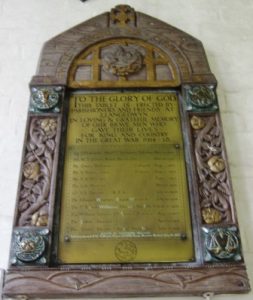
The Great War, 1914-1918
John Charles Chetwynd, Corporal, 9472, York and Lancaster Regiment. John was born in Llangedwyn on 20 August 1890, the son of Edward John Chetwynd and Sarah Chetwynd (nee Griffiths). His father was the schoolmaster at Llangedwyn, before moving his family to Erwood, Radnorshire to take over the position of schoolmaster there. John enlisted into the 1st Battalion, York and Lancaster Regiment at Worcester on 30 April 1909, and was serving in India with the battalion at the outbreak of war. On 22 November 1914 the battalion sailed from Bombay for England, arriving at Southampton on 23 December, moving to Hursley Park to join 83 Brigade, 28th Division. On 17 January 1915 the battalion landed at Le Havre, and entrained for Hazebrouck, before marching to billets in Outtersteene. The Division then marched into the Ypres Salient, and took over a section of the line on the Ypres-Comines Canal at the beginning of February 1915. Over the coming weeks the infantry battalions of the Division began carrying out the usual routines of trench rotation, several days in the front line, followed by several in reserve and several in support, whilst also carrying out working parties. On 22 April the Germans launched an offensive against the Allied lines at Ypres, which came to be known as the Second Battle of Ypres. Poison gas was used for the first time at Gravenstafel, which overwhelmed the French Colonial defenders, and the Canadians had to be rushed forwards to plug the hole in the line. The 28th Division was untouched for now, but the men could hear the din of battle raging to their left, and reports of the gas soon reached the men. The 1st Yorks and Lancs had been relieved by the 1st KOYLI from its positions on the Frezenberg Ridge on 7 May, as the fighting was raging to its left. On the following morning, 8 May 1915, the 1st KOYLI came under heavy shellfire, followed by a strong German attack on their lines, and was forced to withdraw, suffering terrible casualties. The 1st Yorks and Lancs was ordered to advance to retake the trenches, but the battalion suffered so badly that its advance failed. John was killed in action during the fighting that day. The 24-year-old has no known grave and is commemorated on the Ypres (Menin Gate) Memorial, Belgium. John is not commemorated on the Llangedwyn war memorial.
Ernest Edward Davies, Gunner, 56975, Royal Field Artillery. Ernest was the illegitimate son of Catherine Davies, of Wernlas, Llangedwyn. He was raised by his grandparents, Edward and Elizabeth at Wernlas. Ernest enlisted into the Royal Field Artillery at Oswestry soon after the outbreak of war, and on 25 September 1915 embarked for France with the 110th Brigade, Royal Field Artillery. The Brigade was attached to the 25th Division, and after disembarking at Le Havre that day, the Division moved to the Armentieres area, and by 29 October Ernest’s battery took over gun positions and began work. The Division then moved to the Messines sector, where it remained until March 1916, when it moved south, to the Vimy sector, helping fight off a German attack in May. During June 1916 the Division moved out of the sector, and transferred to the Somme, and by 6 July the gun batteries had set up 1 ½ miles east of Bouzincourt before beginning their work, supporting an attack by the 12th Division on Ovillers- La Boiselle. The battery remained in action over the coming weeks from its positions here, supporting the Australian assault on Pozieres soon afterwards. Ernest was wounded during the battle, and was evacuated to No 44 Casualty Clearing Station at Puchevillers, where he died of his wounds on 3 August 1916. He is buried in Puchevillers British Cemetery, France.
Evan Davies, Private, 23153, Royal Welsh Fusiliers. Evan was the son of Allen and Margaret Davies, of Brynyffynon, Llangedwyn. Following the death of his mother, Evan went to work as a farm servant at Caer Fach, Llansilin. Evan enlisted into the Royal Welsh Fusiliers at Llangollen soon after the outbreak of war and was posted to the 10th Battalion, Royal Welsh Fusiliers, which was on Salisbury Plain, attached to 76 Brigade, 25th Division. On 27 September 1915 the Division landed at Boulogne, and two weeks later 76 Brigade transferred to the 3rd Division, which was holding the line at St. Eloi, near Ypres. The Division saw heavy fighting during the Actions of the Bluff in February 1916 and then at the Actions of the St Eloi Craters from 27 March to 16 April, and came under a gas attack for the first time on 29/30 April. By the middle of June the Division had moved out of the Ypres Salient to billets around Eperlecques, where intense training was carried out prior to moving to the Somme sector by 2 July. The main Somme offensive had opened on the previous day, and the 3rd Division was ready to enter the fray, bivouacking at Bronfay Farm by 9 July and on 13 July moved into the captured German lines at Montauban Alley. The 10th RWF took part in heavy fighting over the coming days, and on 19 July received orders for an assault on Delville Wood. Just after midnight the following day the battalion moved forwards and became caught in in terrible fighting within the wood, the fighting of such severity that two men of the battalion were awarded the Victoria Cross. On 25 July the shattered battalion was relieved and moved into reserve, and did not move back into the line until 17 August, when the battalion attacked Lonely Trench. On 23 August the Division moved out of the line to rest and moved to Noeux-les-Mines, near Loos. After a month there, the Division moved back into a rest area for further training before moving back south to the Somme and by 12 November took over trenches at Serre. On the following day, 13 November 1916, the Division launched an assault against the German positions at Serre. The 10th RWF reached Serre village, but the flanking battalions failed to keep up, and heavy losses were suffered, with almost 300 officers and men killed, wounded, or missing. After wintering on the Somme, the Division moved to the Arras sector in February 1917, and took part in the Battle of Arras from 9 April to 16 May, suffering heavy casualties. The Division remained in the same area over the coming months. On 15 July 1917 a party of the 10th RWF took part in a bombing raid on the German lines. Evan and one officer were killed during the raid. Evan was 27-years-old when he was killed that day, and is buried in Louverval Military Cemetery, Doignies, France. Two of his brothers, John and William, were also killed during the war.
John Davies, Private, 12565, South Lancashire Regiment. John was the son of Allen and Margaret Davies, of Brynyffynon, Llangedwyn. He enlisted into the South Lancashire Regiment on 4 September 1914, and was posted to their Depot. On 7 July 1915 John embarked for France and was posted to the 2nd Battalion, South Lancashire Regiment, which was in the Ypres Salient attached to 7 Brigade, 3rd Division. On 18 October the Brigade transferred to the 25th Division, and then a week later, the 2nd South Lancs transferred to 75 Brigade, 25th Division. During October the Division moved south to the Ploegsteert sector, and remained there until March 1916, when it moved south and began a scheme of training before continuing its move south, taking over positions at Neuville-St. Vaast in the middle of April and on 28 May suffered the explosion of an underground German mine, which was followed by a heavy artillery bombardment. At the end of June the Division moved further south to the Somme sector, and attacked on 3 July near Thiepval. John took ill several weeks into the Somme offensive, and was invalided home on 8 September suffering from typhus. After recovering, John embarked at Southampton on 11 January 1917, and re-joined the 2nd South Lancs on 20 January. The Division was by now back in the Ploegsteert Sector, where it remained for the months leading up the Battle of Messines on 7 June 1917. After fighting at Messines, the Division moved north, to the Railway Wood sector, and took part in the Third Battle of Ypres. In September the Division was relieved, and moved to the Noeux-Les-Mines sector. By March 1918 the Division was in position around Bullecourt in reserve, and the men could hear the opening artillery barrage which heralded the opening of the German Spring offensive on 21 March 1918. The Division advanced towards Favreuil and reinforced the Vaulx to Morchies Line, and soon came into contact with the attacking German troops. The Division was pushed back towards Gommecourt over the coming days, before being relieved and moved north to the St. Hilaire sector to rest. Unfortunately, the Germans launched the second phase of their offensive on 9 April, and the 2nd South Lancs, in reserve, was ordered to be readied to move at short notice. On 10 April 1918, with the situation in the front dire, and the line broken, the 2nd South Lancs launched a counter-attacked near Ploegsteert village. John was killed in action during the heavy fighting which followed that day. The 33-year-old has no known grave and is commemorated on the Ploegsteert Memorial, Belgium. Two of his brothers, Edward and William, were also killed during the war.
William Davies, Private, 12335, South Lancashire Regiment. William was the son of Allen and Margaret Davies, of Brynyffynon, Llangedwyn. William was working as a collier at Ashton-in-Makerfield when war erupted, and he enlisted at Warrington into the 6th Battalion, South Lancashire Regiment on 2 September 1914. The battalion formed at Warrington, before moving to Tidworth to join 38 Brigade, 13th (Western) Division. In January 1915 the Division moved to Winchester and on 13 June 1915 sailed from Avonmouth for Alexandria, moving to Mudros before being landed at Cape Helles, Gallipoli from 6 July 1915, relieving the 29th Division. The Division left and returned to Mudros at the end of the month, before landing at ANZAC Cove from 3 August 1915, and joined up with the Anzac’s for their offensive soon afterwards, attacking and holding, for a short period, Sari Bair. William was killed in action during the attack on 10 August 1915. The 29-year-old has no known grave and is commemorated on the Helles Memorial, Gallipoli. Two of his brothers, Evan and John, were also killed during the war.
John Henry Edwards, Sergeant, 355036, Royal Welsh Fusiliers. John was the son of David and Mary Maria Edwards, of Wern Oleu Farm, Llangedwyn. He worked on his parents farm prior to the war. John enlisted into the Montgomeryshire Yeomanry at Llanfyllin on 3 May 1910, and attended the annual TA Summer Camp every year afterwards. On 5 August 1914 the Montgomeryshire Yeomanry was mobilised at Welshpool, as part of the South Wales Mounted Brigade, before moving via Hereford to Thetford, to join the 1st Mounted Division. On 4 March 1916 the 1st Mounted Division sailed for Egypt to join the EEF. On 4 March 1917 the battalion merged with the Welsh Horse Yeomanry to form the 25th (Montgomery & Welsh Horse Yeomanry) Battalion, Royal Welsh Fusiliers, as part of the newly formed 231 Brigade, 74th (Yeomanry) Division. The Division assembled in Egypt as part of the EEF, before crossing the Suez Canal into the Sinai, and saw its first major action during the Second Battle of Gaza. The battle was a failure, and the EEF was re-organised under a new commander, Sir Edmund Allenby, before launching the Third Battle of Gaza on the night of 31 October 1917. This assault was launched along a winder front, running from Gaza to Beersheba, and this time the EEF prevailed, opening the door to Jerusalem. With the Holy City captured, the advance continued and the Turkish troops slowly withdrew north, and Jericho was also captured. In March 1918 the Division took part in operations around Tel Azur, and on 8 March launched an attack on the town of Tel Azur (now part of Tel Aviv), which lies on the Jerusalem to Jaffa road. John was killed in action during 231 Brigade’s assault on the line from Mezrah esh Sherkiyeb—Sheikh Saleh—Burj el Lisaneh, on 9 March 1918. The 27-year-old is buried in Jerusalem War Cemetery, Israel.
Edward Hughes, Private, 15656, Royal Warwickshire Regiment. Edward was the son of Evan and Elizabeth Hughes, of Wernlas, Llangedwyn. He had served with the 1st Volunteer Battalion, Royal Welsh Fusiliers as a young man, before enlisting into the 4th Battalion, Royal Welsh Fusiliers on 31 July 1908, following the creation of the Territorial Army. Edward attended every Annual TA Summer camp over the coming years, until leaving the 4th RWF on 21 November 1910. Edward re-enlisted into the army at Coventry following the outbreak of war, joining the 11th Battalion, Royal Warwickshire Regiment. The battalion formed at Warwick, initially moving to the South Downs to join the 24th Division, but in April 1915 joined 112 Brigade, 37th Division on Salisbury Plain. On 30 July 1915 the battalion landed in France, and the entire 37th Division assembled in the Hazebrouck area before moving to Hébuterne, halfway between Arras and the Somme, for trench initiation. The Division remained in this sector over the coming months, its infantry battalions rotating between front, reserve and support lines, whilst also carrying out working parties. When the Battle of the Somme opened at dawn on 1 July 1916, the 37th Division was on the left flank of the 46th Divisions assault on the Gommecourt Salient, and witnessed the ferocious fighting. The Division then moved south, and by 7 July the 11th Warwick’s had reached Albert, before marching to reserve trenches at Tara Redoubt. On the following afternoon the battalion took over the old German front-line trenches along the Contalmaison to La Boiselle Road, and on 10 July the Division took part in an assault on Contalmaison. The 11th Warwicks then had a brief rest before launching an assault on Pozieres on 15 July. Edward was killed in action to the south of Pozieres on 16 July 1916. The 31-year-old has no known grave and is commemorated on the Thiepval Memorial, France.
Pryce Edward Jones, Private, 37688, Royal Welsh Fusiliers. Pryce was the son of William and Mary Kate Jones, of Scrwgan, Llangedwyn. He lived at Llansilin Road Station, Oswestry prior to the war, and worked as a coal agent. Pryce enlisted into the 3rd Battalion, Royal Welsh Fusiliers at Llanrhaiadr on 15 December 1915, and was posted to Litherland Camp, Liverpool for training. On 15 December 1916, Pryce embarked for France, and was posted to the 13th Battalion, Royal Welsh Fusiliers, which was attached to 113 Brigade, 38th (Welsh) Division. The Division was in the Canal Bank sector at Boesinghe, where it had been posted following its assault on Mametz Wood in July 1916. The infantry battalions of the Division then began carrying out the normal pattern of rotation in the trenches, four days in the front, four in support and four in reserve, whilst also working on trench improvement, digging new trenches, and also carrying out regular patrols and trench raids.On 31 July 1917 the Division launched its famous assault on the Pilckem Ridge, capturing Iron Cross and reaching its objective of the Steenbeek. Pryce was killed in action on the following day, 1 August 1917. The 22-year-old has no known grave and is commemorated on the Ypres (Menin Gate) Memorial, Belgium.
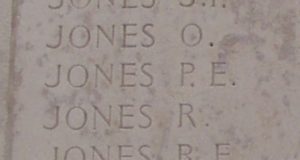
Robert Jones, Private, 14243, King’s Own Yorkshire Light Infantry. Robert was born in Llangedwyn in 1890, the son of Thomas and Catherine Jones. By 1893 the family had moved to Ruabon, and Robert married Florence Ethel Jones, of Froncysyllte, prior to the war. Robert was working in the Rhondda when war broke out, and enlisted at Porth into the 1st Battalion, King’s Own Yorkshire Light Infantry. The battalion had been in Singapore when war was declared, and on 27 September sailed from Singapore, arriving at Southampton on 9 November. The battalion joined 83 Brigade, 28th Division, and embarked at Southampton for France on 15 January 1915, disembarking at Le Havre the following day, and entrained for Hazebrouck, before marching to billets in Outtersteene. The Division then marched into the Ypres Salient, and took over a section of the line on the Ypres-Comines Canal at the beginning of February 1915. Over the coming weeks the infantry battalions of the Division began carrying out the usual routines of trench rotation, several days in the front line, followed by several in reserve and several in support, whilst also carrying out working parties. On 22 April the Germans launched an offensive against the Allied lines at Ypres, which came to be known as the Second Battle of Ypres. Poison gas was used for the first time at Gravenstafel, which overwhelmed the French Colonial defenders, and the Canadians had to be rushed forwards to plug the hole in the line. The 28th Division was untouched for now, but the men could hear the din of battle raging to their left, and reports of the gas soon reached the men. The 1st KOYLI was busied, consolidating its positions on the Frezenberg Ridge as the battle raged, then on 8 May 1915 the battalion came under heavy shellfire, followed by a strong German attack on their lines. Robert was killed in action during the desperate fighting that day. The 25-year-old has no known grave and is commemorated on the Ypres (Menin Gate) Memorial, Belgium. Robert is commemorated on the Froncysyllte war memorial, but not on the Llangedwyn memorial.
William Henry Jones, Private, 285100, Monmouthshire Regiment. William was the son of David and Mary Jones, of Llangedwyn. He had moved to Old Colwyn as a young man to work as a plasterer, and on 17 February 1909 married Ellen Roberts. The couple set up home at 1, Hebron Terrace, Old Colwyn, where they had four children over the coming years. William enlisted into the 2/6th Battalion, Royal Welsh Fusiliers at Wrexham on 25 October 1916. He joined the battalion at Southwold, where it was attached to 203 Brigade, 68th (2nd Welsh) Division. On 1 January 1917 William was transferred to the 1st Reserve Battalion, Monmouthshire Regiment and on 11 June 1917 embarked for France, initially to join the 2nd Battalion, Monmouthshire Regiment. He was instead sent to Ypres, to join the 11th Battalion, South Wales Borderers, which was in the Canal Bank sector at Boesinghe, attached to 115 Brigade, 38th (Welsh) Division. William joined the 11th SWB at Elverdinghe, just before it moved out of the front to Westrehem, to train for the impending opening of the Third Battle of Ypres. On 30 July the 11th SWB moved into its assembly positions on the Canal Bank, in readiness for its attack. On 31 July 1917 the Division launched its famous assault on the Pilckem Ridge, capturing Iron Cross and reaching its objective of the Steenbeek. On the following day 115 Brigade was ordered to cross the Steenbeek and create a bridgehead towards Au Bon Gite. The Germans opened up a murderous artillery barrage on the attacking troops, and the troops dug in and consolidated their gains, in terrible conditions. William was killed in action here on 3 August 1917, just before his battalion was relieved. The 33-year-old has no known grave and is commemorated on the Ypres (Menin Gate) Memorial, Belgium. William is not commemorated at Llangedwyn, but is commemorated on the Old Colwyn war memorial.
John Evan Lloyd, Private, 12247, King’s Shropshire Light Infantry. John was the son of John Lewis Lloyd and Elizabeth Lloyd, of Ffores, Uchaf, Llanrhaiadr-Yn-Mochnant. He worked as a farm servant at Llangedwyn prior to the war. John enlisted at Oswestry into the 6th Battalion, King’s Shropshire Light Infantry soon after the outbreak of war. The battalion formed at Shrewsbury before joining 60 Brigade, 20th (Light) Division at Aldershot, then in April 1915 moved to Larkhill, Salisbury Plain to complete its training. On 22 July 1915 the battalion landed at Boulogne, and the entire Division moved to the St. Omer area, before being sent to the Outtersteene area, before taking over a section of the front at Sailly, in the Fleurbaix sector, for instruction alongside the 8th Division. When the Battle of Loos was launched on 25 September 1915 the Division fought a diversionary attack towards Fromelles. By March 1916 the Division had moved north, and took over a section of the line in front of Elverdinghe Chateau, near La Belle Alliance, on the Canal Bank. The Division was relieved in April and moved to the Wormhoudt area for training, before returning to Ypres and taking over the Railway Wood sector by 25 May. On 2 June the Germans opened up a massive artillery barrage, combined with gas shells, along this section of the front line, before launching on infantry attack, aimed with capturing the Canadian positions at Hill 62 and Mount Sorrel.The 6th KSLI was in the front line when the battle opened, but their section of the line was not involved, and on the following day the battalion was relieved, moving back into reserve, while to their immediate south, the Canadians counter-attacked. Fighting raged for several days, and the front line came under heavy artillery fire at various times. John was killed whilst on a working party in the front line near Railway Wood on 7 April 1916. The 22-year-old is buried in Essex Farm Cemetery, Belgium. John is not commemorated on the Llangedwyn war memorial, but is commemorated on memorials at Llanrhaeadr ym Mochnant and at Pontfadog.
William Thomas Lloyd, Private, 290866, Royal Welsh Fusiliers. William was the son of John and Margaret Ann Lloyd, of Glanrafon, Llangedwyn. He worked as a farm labourer prior to the war. William enlisted into the 7th Battalion, Royal Welsh Fusiliers at Llansantffraid on 25 November 1914. The battalion was a Territorial unit, which mobilised for war at Newtown in August 1914, as part of North Wales Brigade, Welsh Division and moved to Conway until the end of the month, before moving to Northampton. In December the Division moved to Cambridge and then in May 1915 to Bedford, where the Division was numbered and the formation became 158 Brigade, 53rd (Welsh) Division. On 19 July 1915 the entire Division sailed from Devonport for Imbros and on 9 August 1915 landed at Suvla Bay. The infantry moved off the beaches into the bush, but due to a lack of maps and no knowledge of the terrain, many of the units became disorientated, and the situation became chaotic. The Division was eventually evacuated from Gallipoli in December 1915, moving to Egypt to join the EEF, and helped guard the Suez Canal before taking part in operations to drive the Turks out of the Sinai. The EEF then turned its attention onto driving the Turks out of Palestine, and on 26 March 1917 launched its first offensive against the coastal city of Gaza, which guarded the road to Jerusalem. Initial gains during the day were lost when the assaulting divisions lost touch with each other and communication broke down when a thick fog cloaked the battlefield. William was killed in action during the fighting that day. The 25-year-old has no known grave and is commemorated on the Jerusalem Memorial, Israel. He is also commemorated on the Llanrhaeadr ym Mochnant war memorial.
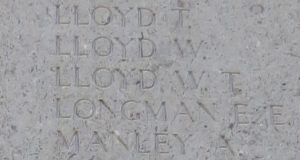
Job Morris, Private, 201081, Royal Welsh Fusiliers. Job was the son of Edward and Ellen Morris, of New Cottage, Llangedwyn. He worked as a farm labourer prior to the war. Job enlisted into the 4th Battalion, Royal Welsh Fusiliers at Llanfyllin soon after the outbreak of war and was probably posted to the 3/4th Battalion, Royal Welsh Fusiliers at Park Hall Camp, Oswestry for training. Job was probably sent to France in the winter of 1917, joining the 1/4th Battalion, Royal Welsh Fusiliers, which was the Pioneer Battalion to the 47th (2nd London) Division. The battalion was north of Arras in November 1917. The Battle of Cambrai opened on 20 November 1917, and on 30 November the 4th RWF moved into the forward area near Bourlon Wood, to the Hindenburg Support Line, some 500 yards west of Flesquières, ordered to garrison that line, in tactical reserve. That afternoon, the Germans launched a counter-attack to retake the ground they had lost. The 4thy RWF in the meantime was hard at work, salvaging, when on 4 December the battalion received orders to retire, as the front line was being withdrawn, and by 7 December the withdrawal was complete. The 47th Division remained in the area over the winter, and by March, the 4th RWF was at work in the Lechelle area, strengthening the Metz Defences. On 21 March 1918 the Germans launched a massive offensive along the section of Western Front running from Croisilles to La Fère, and with the front line under extreme pressure, the 4th RWF was ordered to Stand To in the Pioneer Camp at Lechelle. The men could hear the intensive artillery fire and gun fire in the front, and after receiving orders to take over a line north-east of Lechelle, on the Metz-Trescault road, must have realised that they were about to be plunged into a fearsome situation. During the night the 47th Division, to avoid being outflanked, withdrew to positions at Highland Ridge, and the 4th RWF manned the old lines at Lechelle. On the following day, 23 March 1918, the German infantry hot the Divisions positions, and heavy fighting began. Under intense pressure, the Division was forced to withdraw. Job was killed in action at some time during the fighting that day. The 23-year-old has no known grave and is commemorated on the Arras Memorial, France.
Edward Allen Phillips, Private, 54481, Royal Welsh Fusiliers. Edward was the son of Ebenezer and Maria Phillips, of Bryngolen, Llangedwyn. He worked as a waggoner prior to the war. Edward enlisted at Newtown into the Welsh Horse Yeomanry soon after the outbreak of war, and was posted to Yoxford to join the 2/1st Battalion, Welsh Horse. He was drafted to France in the winter of 1916-17, joining the 14th Battalion, Royal Welsh Fusiliers, which was attached to 113 Brigade, 38th (Welsh) Division. Edward joined the battalion on the Canal Bank at Boesinghe, where it had moved to following its epic assault on Mametz Wood in July 1916. The infantry battalions of the Division then began carrying out the normal pattern of rotation in the trenches, four days in the front, four in support and four in reserve, whilst also working on trench improvement, digging new trenches, and also carrying out regular patrols and trench raids. On 31 July 1917 the Division launched its famous assault on the Pilckem Ridge, capturing Iron Cross and reaching its objective of the Steenbeek, then played a supporting role in the Battle of Langemarck. The Division was transferred to the Sailly-sur-la-Lys sector in September, and remained in the area over the winter before being moved to positions north of Albert, at Bouzincourt Ridge, at the end of March 1918, relieving the battered 2nd and 47th Divisions. It held this sector, again carrying out minor operations and trench raids, over the coming months, before taking part in the great offensive of 21 August 1918, and began its advance towards the Hindenburg Line. Over the coming days the Division advanced across the old Somme battlefield of 1916, recapturing Thiepval, Pozieres, Mametz Wood and Bazentin, before taking Longueval and Delville Wood. Edward was wounded during the advance, and died of his wounds at the 34th Casualty Clearing Station on 27 August 1918. The 22-year-old is buried in Fienvillers British Cemetery, France.
Milton Mial Richards, Private, 31467, South Wales Borderers. Milton was the son of John and Sarah Richards, of Bronhaul, Bwlchyddan, Llangedwyn. He enlisted into the army at Wrexham, and after completing his training was posted to France in the late summer of 1917, joining the 10th Battalion, South Wales Borderers, which was attached to 115 Brigade, 38th (Welsh) Division. Milton probably joined the battalion after its epic assault on the Pilckem Ridge on 31 July 1917. The Division was transferred to the Sailly-sur-la-Lys sector in September, and remained in the area over the winter before being moved to positions north of Albert, at Bouzincourt Ridge, at the end of March 1918, relieving the battered 2nd and 47th Divisions. It held this sector, again carrying out minor operations and trench raids, over the coming months, before taking part in the great offensive of 21 August 1918, and began its advance towards the Hindenburg Line. Over the coming days the Division advanced across the old Somme battlefield of 1916, recapturing Thiepval, Pozieres, Mametz Wood and Bazentin, before taking Longueval and Delville Wood. By 31 August the Division was held up in front of Lesboeufs, but on the following day the 2nd RWF and 17th RWF of 115 Brigade attacked and captured the ruined village, with the 10th SWB in support. Milton was killed in action on the following day, 2 September 1918, whilst the 10th SWB was advancing to a line near Sailly-Saillisel. The 20-year-old has no known grave and is commemorated on the Vis-en-Artois Memorial, Haucourt, France. Milton is not commemorated at Llangedwyn, but is commemorated on the Llanrhaeadr ym Mochnant war memorial.
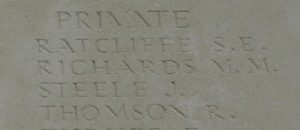
Owen Williams, Private, 760, Royal Welsh Fusiliers. Owen was the son of Frances Williams (nee Davies), of Bwlchyddar, Llangedwyn. He was already serving with the 7th Battalion, Royal Welsh Fusiliers when war declared, having enlisted at Llanfyllin several years prior to the war. The battalion was a Territorial unit, which mobilised for war at Newtown in August 1914, as part of North Wales Brigade, Welsh Division and moved to Conway until the end of the month, before moving to Northampton. In December the Division moved to Cambridge and then in May 1915 to Bedford, where the Division was numbered and the formation became 158 Brigade, 53rd (Welsh) Division. On 19 July 1915 the entire Division sailed from Devonport for Imbros and on 9 August 1915 landed at Suvla Bay. The infantry moved off the beaches into the bush, but due to a lack of maps and no knowledge of the terrain, many of the units became disorientated, and the situation became chaotic. Owen was killed in action on the following day, 10 August 1915. The 21-year-old has no known grave and is commemorated on the Helles Memorial, Gallipoli.
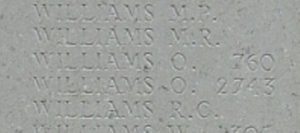
Peter Trevor Williams, Private, 79610, Devonshire Regiment. Peter was born on 6 February 1896, the son of William and Margaret Williams of Tynybwlch, Llansilin. His father was the carpenter on the Llangedwyn Estate. Peter enlisted into the army, and was posted to the 15th Battalion, Devonshire Regiment. The battalion had been formed on 1 January 1917 from the 86th Provisional Battalion and moved to Herne Bay. During 1918 the battalion moved to Aldeburgh where it remained. Peter died in Norfolk War Hospital, Thorpe St. Andrew on 7 July 1918. The remains of the 22-year-old were conveyed home for burial in St. Cedwyn’s Churchyard, Llangedwyn.
World War Two, 1939-1945
John Owen Jones, Gunner, 968668, Royal Artillery. John was the son of John Morris Jones and Elizabeth Jane Jones, of Canol Aren, Llangedwyn. He enlisted into the Royal Artillery, and was posted to the 60th Field Regiment, Royal Artillery, a Territorial unit. The two batteries of the regiment went to France in January 1940, and moved to Bois Grenier, near Armentieres. Following the German Blitzkreig, the regiment saw much fighting, before being evacuated from Dunkirk. The regiment embarked for the Middle East in January 1941, and disembarked in Egypt, before one battery of the regiment was sent to Iraq. John was sent to Palmyra in Syria with 237 Battery of the regiment, and took part in several actions against the Vichy French troops in the area. John was killed in Syria on 23 June 1941. The 24-year-old is buried in Damascus Commonwealth War Cemetery, Syria.
Albert Reynolds, Private, 1808363, The Queen’s Royal Regiment (West Surrey). Albert was the son of James and Mary Ann Reynolds, of Llangedwyn. He enlisted into the army and was posted to the 2/6th Battalion, The Queen’s Royal Regiment (West Surrey). The battalion had fought during the fall of France in 1940, attached to 169 (Queen’s) Brigade. In 1942 the battalion embarked for North Africa with the brigade, and joined the 56th London Division, before taking part in the capture of Tunis in May 1943. The brigade then took part in the allied landing at Salerno, Italy in September 1943, before taking part in the slow advance north through Italy. Albert was killed in Italy on 12 November 1944. The 23-year-old is buried in Ancona War Cemetery, Italy.
Leonard Roberts, Private, 13030212, Hampshire Regiment. Leonard was born on 27 December 1914, the son of William R Roberts and Emma Roberts (nee Oakes), of Bucklow, Chester. He married Ethel Davies, of Llangedwyn, in 1940. Leonard enlisted into the army and was posted to the 1st Battalion, Hampshire Regiment, which by April 1943 had moved to North Africa. In July 1943, the Battalion took part in Operation Husky, the invasion of Sicily, and saw heavy fighting against the Herman Goring Parachute Panzer Division. The battalion saw further heavy fighting on Sicily over the coming weeks, before landing in Sicily on 8 September 1943. The battalion took part in the slow advance north, before returning to England by November 1943, to prepare for the D-Day Landings. The battalion joined the 50th (Northumbrian) Infantry Division, and on 6 June 1944 landed on Normandy, capturing Le Hamel and Arromanches. At the end of June the battalion began to attack the village of Hottot, against the German Panzer-Lehr-Division, and on 11 July 1944 the battalion saw severe fighting against this elite German unit. Leonard was killed in action during the fighting that day. The 29-year-old was originally buried near Hottot, with several other men, but in September 1945 their graves were relocated into Bayeux War Cemetery, France.
Watkin Williams-Wynn, Lieutenant, 338701, Royal Armoured Corps. Watkin was born on 6 April 1925, the son of Sir Watkin Williams-Wynn, 8th Baronet, JP, and of Lady Marguerite Williams-Wynn (nee Houghton), of Wynnstay. He enlisted into the 1st Dragoon Guards, and received an emergency commission as Second Lieutenant into the regiment on 14 December 1944. The 1st Royal Dragoons were attached to the Royal Armoured Corps, so Watkin would have taken part in the successful drive through Holland into Germany. He died in Barnard Castle, County Durham at some time between 17 and 18 January 1946. The remains of the 20-year-old were brought home to Llangedwyn for burial in St. Cedwyn’s Churchyard.
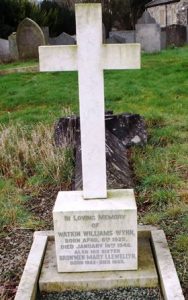
Northern Ireland, 1972
Robert Watkin Williams-Wynn, Lieutenant, 489220, 14th/20th Hussars. Robert was born on 11 April 1948, the son of Sir Owen Watkin Williams-Wynn, 10th Baronet, and Margaret Jean Williams-Wynn (nee Mcbean), of Llandegwyn Hall and of Bodelwyddan Castle. His father had been a prisoner of the Japanese during World War Two. Robert was commissioned into the 14th/20th Hussars in June 1970, and was posted to Northern Ireland with the regiment. On 13 July 1972, Robert was commanding an armoured car unit, which was reportedly attempting to flush out gunmen in the Lenadoon area when a firefight broke out. Robert and Fusilier Kenneth Canham were shot dead, together with a number of civilians, including a 5-year-old boy from Lenadoon. Robert was 24-years-old.
The Great War, 1914-1918
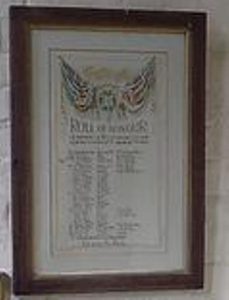
There is also a memorial to all of the Parishioners who served and returned during the Great War, which is located inside Llangedwyn Church. The memorial takes the form of a framed and glazed roll of honour, and also hangs inside the Church. The memorial commemorates 34 men of the Parish who served, including four who fell, during the war:
Allison, Thom
Davies, D
Davies, J L
Davies, William
Edwards, E J
Edwards, W
Evans, Edward
Evans, William
Howell, ?
Hughes, David
Hughes, Edward
Hughes, Hugh R
Hughes, John T
Hughes, Wm Ernest
James, Wm T
John, Percy
Jones, John Evan
Jones, Robert
Lloyd, John
Lloyd, John E
Lloyd, Zachariah
Morris, David
Morris, Richard
Richards, Robert
Richards, Thomas
Richards, Willie
Roberts, William
Sides, R
Vaughan, John E
Vaughan, Samuel
Vaughan, W David
White, Douglas
White, Eric
Williams, W